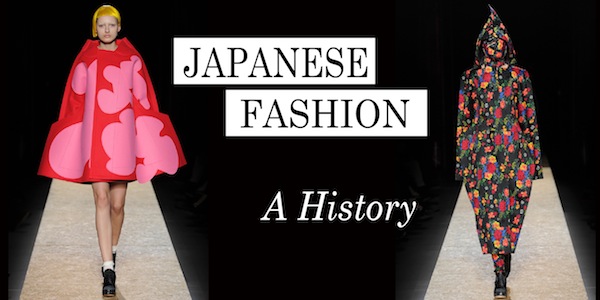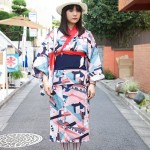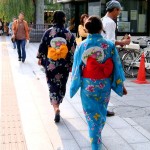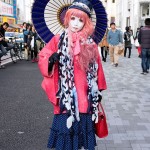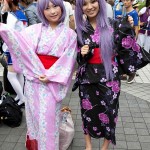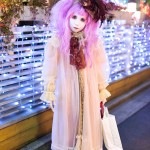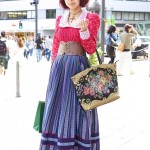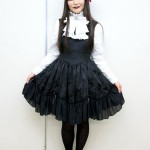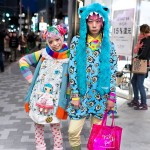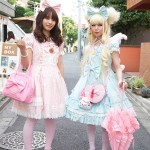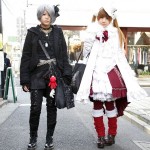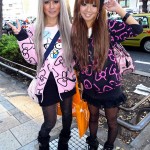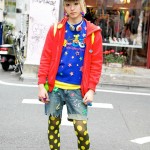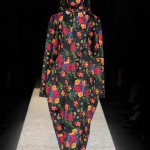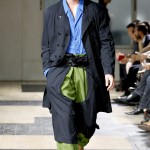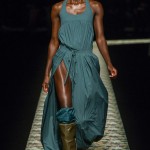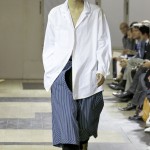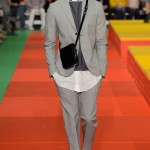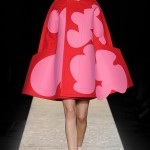by Ashley Garner
It was no surprise this season when Prada sent models out on the runway in garments folded like origami and shoes resembling Harijuku towering platforms and Japanese judo socks made of leather and bows. European and American designers have always drawn inspiration from the East. Think Dior haute couture Spring 2007, Proenza Schouler Fall 2012, or even Rodarte’s Mullevay sisters drawing a large amount of their inspiration from manga and anime horror films. Eastern inspiration can be found almost anywhere and everywhere right now but do we really know what the history behind it is?
“My clothes are about human beings: they are alive.
I am alive.”
Yohji Yamamoto
Many are familiar with what a traditional kimono looks like but what they may not know is that it dates as far back as the 5th century. The design of the kimono was heavily influenced by the Han Chinese Clothing today known as hanfu. From the 8th century and forward the design of the kimono became increasingly stylized with half aprons layered on top of them, worn without trousers or divided skirts and tied together with an obi belt that over the years became wider and tied in very intricate knots. Also the length of the sleeves on kimonos became much longer depending on whether a woman was married or not. By the Edo period (1603-1867) the kimono reached its peak in design and has more or less remained unchanged since. Most kimonos were made of the finest silks and materials and considered great works of art.
When men and women weren’t wearing their specialty kimono’s they dressed down into casual summer kimono’s called yukata’s. Made from cotton or synthetic fabric and unlined these garments were sewn with straight seams and wide sleeves, much like the kimono. Men would generally have shorter sleeves than women. The yukata would be worn with a cotton undergarment (juban), an obi belt, sandals (geta), and a carrying bag (kinchaku). Younger people who wore yukata’s would have them in bright, vivid colors and bold patterns while older people would wear dark, muted colors and dull patterns. Since the 1990’s yukata’s have made a comeback in fashion and are a common sight in Japan. Although these traditional garments can still be found widespread in China and Japan they hardly represent the current fashions seen in these areas today.
TRADITIONAL KIMONO & YUKATA GALLERY
It was only a matter of time for Tokyo, Japan to be named one of the top 5 fashion capitals of the world. Shibuya, one of the 23 special wards of Tokyo, is home to Tokyo’s most famous shopping district and busiest railway stations. For the last 30 years Shibuya has been a haven for youth culture and contemporary fashion, which extends northward to Harajuku, another train station and fashion capital within the Shibuya ward of Tokyo. In Harajuku you can find a plethora of young people in unique street fashion that is seen in no other place in the world and is promoted in several publications such as Kera, Tune, Gothic & Lolita Bible, and Fruits.
Several of the styles seen in Harajuku dawned by “Harajuku girls” include gothic, punk, ganguro, Lolita, kawaii, visual kei, and cosplay. Within the Lolita trend there are many sub-trends to it, including Sweet Lolita where girls are often seen wearing soft pastel colors, bow’s in their hair, white stockings, and anything frilly with cupcake prints or polka dots on it. Gothic Lolita is composed of only black and white as the color choices. There is a much more solemn and gloomy mood to this style although you will still find lots of bows on dresses and in girls’ hair. Guro Lolita is inspired by slasher and horror films with girls wearing bleach white dresses with blood splatters all over. There is a variety of this style that includes playing the victim or a hospital nurse with an eye patch and mouth covering. Often the blood splatter will also be on the face and hair of the wearers of this style. Then there is Country Lolita that is inspired by the American Western frontier. Girls wear dresses made of cotton and modest floral or checkered prints paired with white bonnets and wicker baskets as purses. Finally there is Kuro and Shiro Lolita. Girls wear all black with corset ribbons on the front of their dresses, black lace and platform heels; or they take a completely opposite route and wear all white with a variety of white hats and bows in their hair and knee high stockings.
HARAJUKU STREET FASHION GALLERY
Kawaii fashion is a branch of the kawaii culture in Japan. Literally meaning “lovable” “cute” or “adorable” kawaii refers to a quality of cuteness in Japanese culture. Needless to say, if you have ever wanted to know how to look cute, embracing Japanese fashion is a fantastic way to pull off this adorable style. Over the years kawaii has taken on new meanings such as cool, desirable, charming, or non-threatening. Within Japan women often try to act cute to attract men, and a cosmetic company quickly found that women in their 20’s and 30’s favored the “cute look” with a childish round face. Kawaii started as an underground movement with teenagers involving a way of speaking, writing, and dressing. Since its emergence in the 1980’s it has sparked the founding of Hello Kitty and Pokemon and has begun influencing day-to-day mannerisms that emphasize helplessness and the innocence of young girls. Kawaii is one of the most popular sub-cultures in Asia and has now become a world-wide industry.
Several of the other sub-cultures seen in Harajuku include Cosplay, also known as costume play or role playing. Boys and girls wear costumes and accessories to represent a specific character or idea. Cosplayers often interact with each other in an effort to create a subculture based on role playing apart from the stage or cultural context. Some of the more popular costumes within cosplay include anime costumes due to the fact that such shows enjoy vast fanbases whose members want to engage with the franchises in a physical way, leading many to dress like their favorite characters! Such costumes are available to purchase online. Visual kei is another movement seen among Japanese musicians. It is characterized by heavy make-up, elaborate hairstyles, and flamboyant costumes. It is related to a sub-genre of Japanese rock music that is similar to glam rock, punk rock, or heavy metal.
With all of these flamboyant trends roaming the streets of Tokyo it’s no surprise that some of the most successful and innovating designers come from this area. Companies such as A Bathing Ape and Billionaire Boy’s Club have gained much commercial success across the globe, particularly among the rap and R&B music culture. Within the high fashion world designers such as Kenzo, Issey Miyake, Yohji Yamamoto, and Rei Kawakubo for Comme des Garcons have changed the way the world see’s fashion today.
JAPANESE FASHION RUNAWAY GALLERY
For example, Rei Kawakubo created the style “post nuclear chic” where clothing is purposefully sewn jagged, hems unfinished, and clothing draped in an old tradition to represent a conceptual idea and become a wearable work of art. Issey Miyake created a brand new type of material through intricately pleating a special blend of polyester, twisting it tightly and then treating it with heat to hold the pleats for a lifetime. This type of manufacturing began the now famous Pleats Please that involves working with fine artists, comic artists, and a collaborative of designers making prints for these pleated garments. Lastly there is Yohji Yamamoto who in the 1980’s presented his collection to a Western audience and turned the idea of fashion being about structure, sex, and glamour on its head. Labeled as Hiroshima chic Yamamoto composed androgynous shrouds in several shades of black, worn with flat shoes, little make-up and a stern expression. He says, “My clothes are about human beings: they are alive. I am alive.” His vision of women and men as independent, intelligent, liberated artisans has made him a fashion legend.
Another famous Asian artist that has recently made her debut in the fashion world is Yayoi Kusama who collaborated with Louis Vuitton and her obsessive polka dots.
Although knowing the history of fashion is very important it is also an industry about looking forward. The next up and coming designers from the depths of Tokyo include Facetasm, a brand dedicated to mixing colors and genres, creating daring combinations for men. Then there is Ato, an urban spirit of graphic t-shirts, stylish backpacks and couture details recently favored by Kanye West. Last but not least is Whiz Limited who is dedicated to evolution. After collaborating with Levi’s the designer is now pushing technical materials into his work and trying to create the next generation of clothing.
To say that Asian Sensation is just a trend that comes and goes is ignorant as Tokyo, Japan is years ahead of us in fashion and trends. It’s only a matter of time until there are more than just a handful of influential Japanese brands in the Western market, as seen with these up and coming menswear and women’s wear designers.



